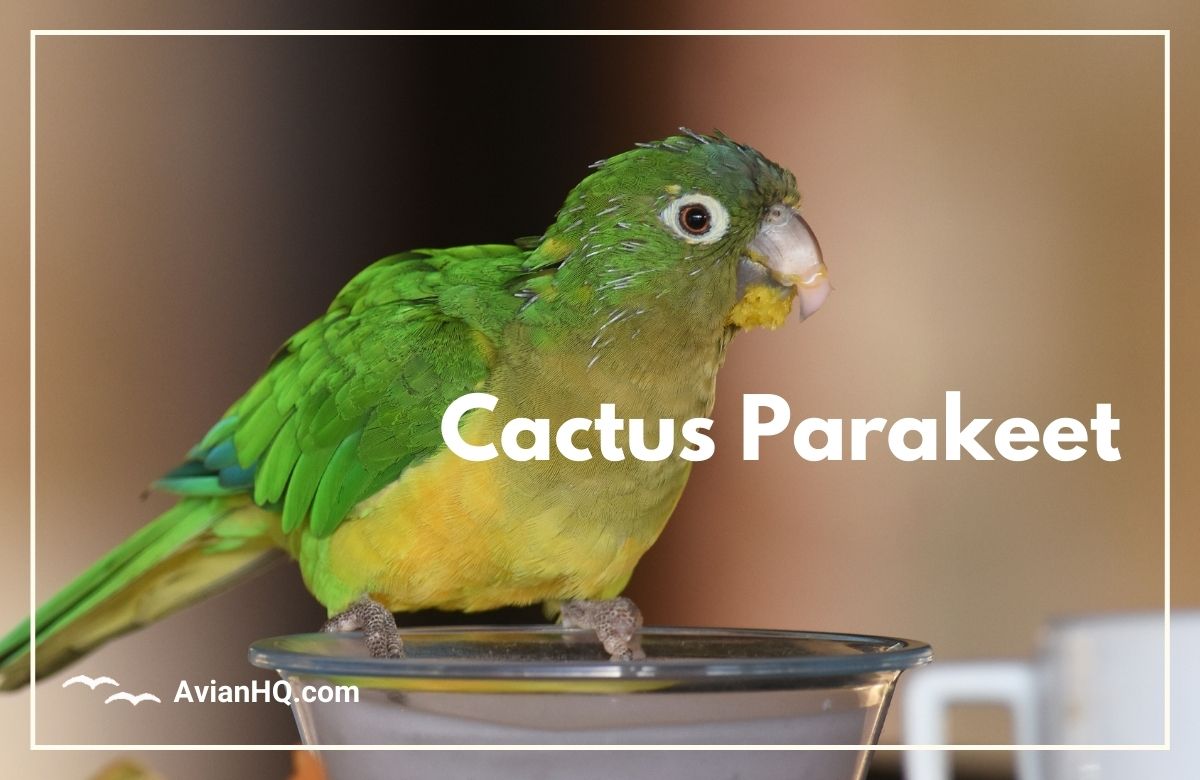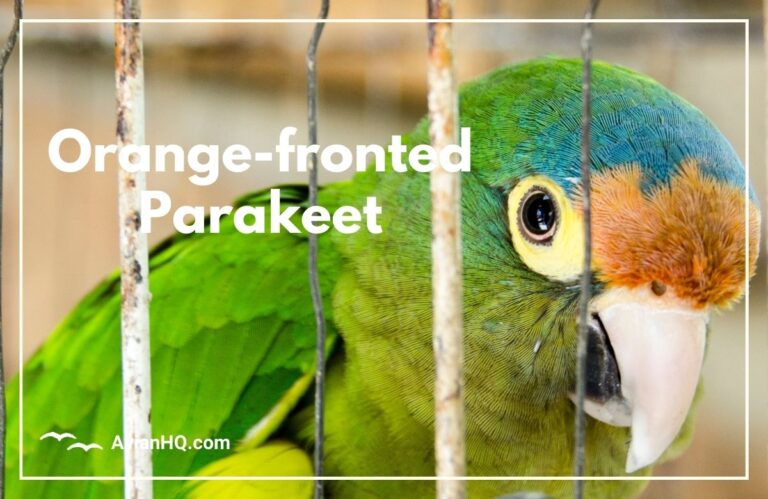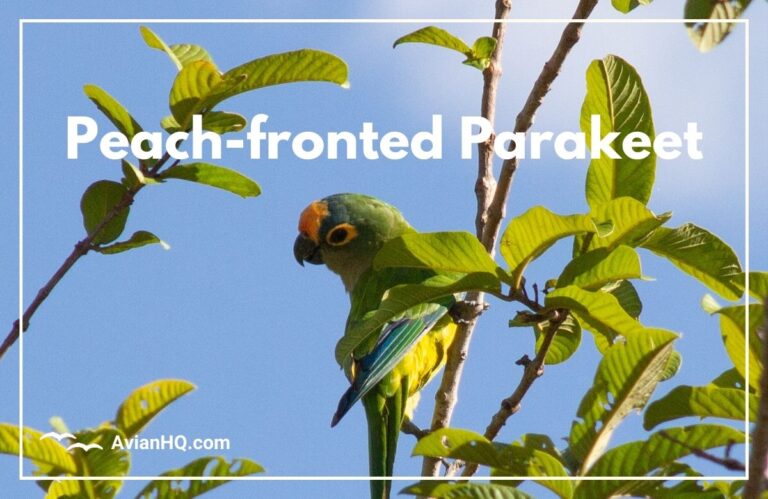Cactus Parakeet (Eupsittula cactorum)
Have you ever seen a bright green parrot flying through the desert or perched on a tall cactus? If so, you may have spotted the Cactus Parakeet (Eupsittula cactorum), a small and uniquely Mexican parrot. As its name suggests, this little bird has adapted perfectly to make its home in the arid landscapes of Mexico.
Weighing only 50-60 grams (1.8-2 ounces) and reaching lengths of 9-11 inches (23-28 cm), the Cactus Parakeet stands out with its vibrant green plumage accented by blue-tipped wings and tail feathers. Its curving beak packs a surprising punch, able to crack open hard seeds and cactus fruits. Using this sturdy beak, these resourceful birds can thrive in dry habitats where food and water are scarce.
The Cactus Parakeet is a highly social and vocal species, gathering in flocks of 10 to 30 birds that travel together between feeding and roosting sites. Their loud squawks reveal their location as they swoop over thorny trees in search of fruits and flowers. These parakeets are creative nest builders, often choosing cavities high up in cacti where they can enjoy protection from predators.
As Mexico’s only endemic parakeet species, the Cactus Parakeet is a symbol of resilience and adaptation. Unfortunately, habitat loss threatens the future of this unique desert dweller. Learning more about how Cactus Parakeets make their homes in harsh environments can help guide conservation efforts. Read on to uncover the amazing survival strategies of this little parrot.
History and Taxonomy
The Cactus Parakeet entered the scientific record books in 1856 when British ornithologist Philip Lutley Sclater first described the species. Collecting a specimen near Jalapa, Mexico, Sclater named the small green parrot Conurus cactorum in reference to its affinity for cacti. The name remained unchanged until 1997 when the parakeet was reclassified into the genus Eupsittula, which includes several other Latin American parakeets.
This reorganization came after analyzing the Cactus Parakeet’s evolutionary relationships with other parrot species. Scientists found its closest relatives to be other Mexican and Central American parakeets like the Olive-throated Parakeet, Aztec Parakeet, and Brown-hooded Parakeet. All Eupsittula parakeets likely evolved from a common parakeet ancestor that inhabited Mexico and diversified into new species across Central America.
Today, the Cactus Parakeet remains the sole species within the genus Eupsittula to live exclusively in Mexico’s arid habitats rather than tropical forests. As the country’s only endemic parakeet, it serves as an important representative of Mexico’s unique native biodiversity. The Cactus Parakeet’s long presence across Mexico is evident by accounts of Aztec traders transporting captured parakeets inland from coastal areas in the 15th and 16th centuries.
Physical Appearance
The bright plumage of the Cactus Parakeet makes it stand out against the muted desert backdrop. Its main color is a vibrant green, with a yellowish tint on the undersides of its wings and tail. The parakeet’s wings and long tail feathers are accented with brilliant blue tips, these blue markings being most prominent on mature adult birds.
These petite parakeets reach lengths of 9-11 inches (23-28 cm) from beak tip to tail tip. Their wingspans stretch 20-22 inches (51-56 cm) wide. Weighing just 1.8-2.1 ounces (50-60 grams), the Cactus Parakeet is one of the smaller parrot species. Still, it boasts a sturdy build with a strong curved beak suitable for prying into tough fruits and seeds.
Mature males and females have identical plumage colors, but can be differentiated by subtle physical size differences. Male Cactus Parakeets tend to have broader heads and thicker beaks relative to their body size compared to female birds. Identifying gender differences is also easier when observing pairs side-by-side, with the male parakeet often positioned protectively closer to the nest cavity.
Like other parrots, Cactus Parakeets undergo a molting process each year where old worn feathers are shed and replaced with new growth. Their vibrant colors may fade slightly after molting, but quickly regenerate within weeks or months. The blue wing and tail markings develop slowly over the parakeet’s first year, allowing easy distinction between young fledglings and mature adults.
Habitat and Distribution
The Cactus Parakeet is endemic to Mexico, found nowhere else in the world. Its habitat range closely hugs the Pacific and Gulf coastal regions, stretching from central Sonora state south across western Mexico as far as Oaxaca.
These parakeets thrive in hot, arid environments where temperatures average 68-100°F (20-38°C). They frequent dry forests and scrublands populated with thorny trees and cacti that provide both shelter and sustenance. Two of their favorite cactus species are towering organ pipe cacti and prickly pears.
Cactus Parakeet populations tend to concentrate in west-central Mexico, particularly the states of Jalisco, Colima, Michoacán, and Guerrero. High numbers also inhabit Mexico’s Yucatán peninsula. Their geographic distribution overlaps in some areas with the closely related Olive-throated Parakeet; the two species may interbreed where their ranges meet.
Though widespread, Cactus Parakeets do not undertake long seasonal migrations. Most groups remain year-round in the same general territory they inhabit. They may migrate short distances to follow ripening cactus fruits, but these movements happen across a limited range. Protecting localized populations is key to conserving genetic diversity that allows adapting to their harsh desert world.
Diet and Feeding
The Cactus Parakeet’s specialized beak and feet equip it perfectly to harvest a varied diet from Mexico’s arid landscapes. These resourceful birds primarily eat fruits and seeds, but also enjoy blossoms, cacti pulp, berries, nuts, and even occasional insects.
Hard seeds from trees like mesquite provide a mainstay food source. The parakeet’s strong beak can easily crack open the seeds’ tough outer coatings. They also forage diligently on ripe fruits and fleshy pods from acacia, guamúchil, huisache, and other desert plants. Prickly pear cactus fruits offer an important source of free-flowing water in addition to nourishment.
Cactus Parakeets often gather near flowering trees like tabachín, descending in groups once blossoms erupt. They play a key role spreading these plants’ pollen and seeds across the desert ecosystems where few other nectar-feeders live. Their year-round residence makes them reliable pollinators.
These active birds spend most of the daylight hours busily foraging and feeding. They drink mainly in the early morning and gather most food during their two intensive feeding periods – several hours after dawn and before dusk. Hard seeds and fruits make up the majority of their nutrition, though blooming plants provide a sugary energy boost.
In the wild, mature Cactus Parakeets usually feed every 3-4 hours. Captive parakeets should be offered a variety of fruits, greens, seeds, pellets and clean drinking water. Providing enrichment like puzzle feeders also helps stave off boredom and feather damaging behaviors.
Breeding and Reproduction
The breeding season for Cactus Parakeets kicks off as the desert spring blooms, spanning February through May. Though these sociable birds live year-round in loose flocks, mature adults pair off to breed and nest. The parakeet pairs cement bonding by preening each other’s head and neck feathers.
Male suitors also offer female partners choice morsels of food during courtship feeding. Once paired, couples break away from the main flock while nesting and rearing young. The monogamous pairs often reunite year after year, adding fresh nesting material to refurbish their old nest sites.
Cactus Parakeets nest in existing cavities with protective thick walls, favoring hollows located high up in columnar cacti like Mexican giant cardón and organ pipe. The birds line the deep nests with a cozy base of plant down and feathers before the female lays eggs. She produces one small white egg daily, until completing a typical clutch of three to five eggs.
Only the female incubates the eggs, keeping them warm beneath her body brood patch for about 24 days straight. During this period, the male regularly brings food to feed his mate. Once the chicks hatch, both parents gather food and take turns feeding the demanding young parakeets multiple times per hour.
The fast-growing chicks are ready to try climbing out on nest ledges at six weeks old. By nine to twelve weeks, the juveniles have fledged and can fly capably alongside their parents to join the greater flock. Young birds reach full maturity and their adult plumage after one year. Most Cactus Parakeets can breed successfully by their second spring season.
Behavior and Ecology
Cactus Parakeets exhibit highly social behaviors as part of close-knit flocks. Each flock occupies a home territory where the birds roost communally and forage together daily. Flocks wander across zones stretching up to 5 square miles (13 square km) following the seasonal bloom cycles of different food plants.
These vocal parakeets maintain constant contact with a mix of squawks, chirps, and whistles. Their loud voices not only strengthen social bonds but also warn of any potential predators spying nearby. Cactus Parakeets remain actively visible during daylight hours spent busily feeding, preening, or just sunbathing on treetop perches.
At dusk the flocks gather to settle into community roosting spots, which shift between sites from night to night. Thick flowering trees offer protective cover, but tall columnar cacti make the best fortress-like roosts. Groups huddle together on sheltered ledges, waiting until peak heat passes before emerging to resume foraging each morning.
Beyond their bonded flocks, Cactus Parakeets adjust behaviors seasonally to handle Mexico’s challenging climate. Soaring summer temperatures drive them to seek shadier spots and succulent, water-filled cactus fruits. Seasonal flowering cycles bring flocks together socially when abundant blossoms erupt.
During late winter months food becomes scarcer in Mexico’s arid habitats. This may trigger short movements of 20-30 miles (30-50 km) to areas with better forage as part of the parakeets’ survival strategy. But most birds will eventually return to their core home ranges.
Conservation Status
The Cactus Parakeet has an extensive distribution across western Mexico but its specialized habitat makes it vulnerable. As Mexico’s only endemic parakeet, it serves as an “umbrella species” where protecting its dry forest ecosystem also preserves many other native plants and animals.
Its global population numbers between 120,000–499,999 mature individuals, according to the IUCN Red List. Overall the Cactus Parakeet is evaluated as Least Concern, but the species faces worrisome localized declines. Habitat destruction poses the largest threat, with logging and land clearing eliminating native vegetation parakeets depend on for shelter and food.
For example, cutting organ pipe cacti not only removes nest sites but also a crucial calcium and water source for breeding birds. Trapping for illegal trade has also reduced some regional populations. Establishing protected wilderness preserves can help counter habitat loss in vital areas.
Community education and enforcing existing poaching bans are equally vital for the Cactus Parakeet’s future. Allowing traditional sustainable harvesting of chicks while limiting adults captured helps balance human use with conservation. Maintaining healthy flocks of these uniquely adapted parakeets ensures their vital pollination roles continue across Mexico’s vulnerable dry forests.
Cultural Significance
The bright green Cactus Parakeet holds a special place in Mexican culture and history. These common parrots were familiar sights to ancient civilizations like the Aztecs across Mexico’s arid landscapes. Early recorded accounts describe traders transporting captive parakeets in woven reed cages to inland cities where the colorful birds were sold as pets.
Parakeet feathers and imagery adorned ritual costumes and royal headresses in pre-Hispanic times. The Aztecs compared military squadrons to flocks of parakeets in codex writings. These symbols endure today, with Cactus Parakeets featured on Mexican postage stamps honoring native wildlife.
Contemporary artwork also depicts the parakeet to represent resourcefulness and survival. As Mexico’s only endemic parrot, the Cactus Parakeet remains a cultural icon symbolizing the country’s distinctive natural heritage. Its Spanish name “perico cactus” rings familiar as a household term for any parakeet.
Beyond their symbolic significance, Cactus Parakeets contribute year-round ecosystem services. As prolific desert pollinators, the birds assist propagation for dozens of dry forest plants bearing fruits, seeds, and nectar they favor. Protecting healthy parakeet numbers ensures survival of interlinked native wildlife.
While still captured for the pet trade, improved regulations allow sustainable harvesting. New generations of captive-bred birds help supply consumer demand. Boosting community education programs showcases the Cactus Parakeet’s important cultural and ecological roles across Mexico’s magnificent landscapes.
Conclusion
The Cactus Parakeet stands as a uniquely adapted bird, making its home in Mexico’s challenging arid environments. Weighing barely two ounces yet boasting the tenacity to crack hardy desert seeds, these small parrots display remarkable resilience. Their bright plumage and vocal social antics add a splash of vitality to harsh scrublands.
As Mexico’s one true endemic parakeet, the Cactus Parakeet serves as an importantsymbol within the nation’s culture and history. Wild populations face worrying declines from habitat loss and trapping. Safeguarding its specialized ecological niche protects not just this species but many other native organisms relying on the same desert oases.
Providing formal protection to vital cactus forest habitats can allow Cactus Parakeet numbers to rebound. Coupled with community education, sustainable harvesting, and captive breeding efforts, balanced conservation strategies can ensure these unique parakeets endure for future generations.
The tiny Cactus Parakeet plays an oversized ecological role in pollinating cacti and seed-bearing desert trees. Saving Mexico’s distinctly adapted “perico cactus” remains key for preserving vital connections between the country’s arid landscapes and diverse human cultures. With supportive conservation measures, these tenacious parrots can brighten Mexico’s magnificent deserts for centuries to come.








слушать мп3 музыку онлайн бесплатно в хорошем качестве http://www.25kat.ru/ .